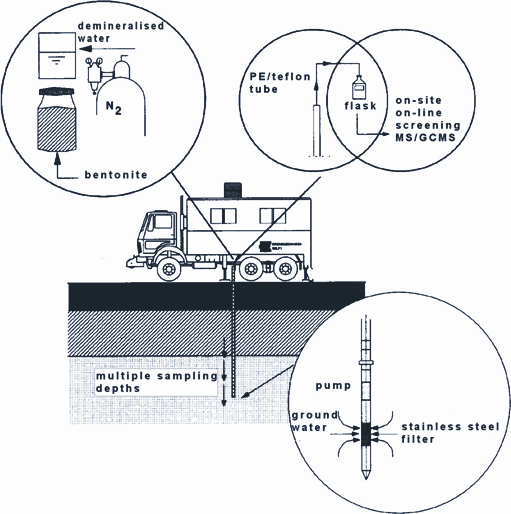Buy the Book
Published By Lankelma
Lankelma is the foremost contractor for onshore in-situ soil testing in the UK. An acknowledged
specialist in CPT, Lankelma also offers a worldwide consultancy and training service.
A.P. van den Berg develops, designs and manufactures geotechnical and environmental soil
investigation equipment for onshore and offshore applications. Specialists in CPT systems and equipment.
Gardline
Gardline Geosciences offers worldwide marine geotechnics, in-house consutancy and services with marine
investigations ranging from nearshore to full ocean depth (down to 3000m).
About the Author
Hans Brouwer studied civil engineering at Delft University in The Netherlands. He has
worked as a part-time lecturer at Amsterdam Polytechnic and was senior partner in a structural
engineering consultancy. He has written a standard textbook in Dutch about the design of
building foundations. He now lives in England where he writes technical textbooks in
English, hopefully to reach a bigger readership.
Quick Links:
Chapter 5
Sampling probes
Delft multi-level groundwater sampling probe
| |
DELFT MULTI-LEVEL GROUNDWATER SAMPLING PROBE 5.5
General principle
Most of the various groundwater samplers share the disadvantage that
the level where the sample is taken must be pre-determined. Only after
a sample has been taken and analysed will it be become apparent that
the chosen sampling depth was correct and useful.
To overcome this problem GeoDelft has developed the multi-level
groundwater sampling probe (Figure 46). With this method,
groundwater samples can be retrieved from multiple sampling depths
during a single CPT operation. This sampling probe has been tested
and validated thoroughly, taking into account all possible crosscontamination
processes.
|

| | Figure 46 Main elements in the multi-level groundwater sampling probe
(source: GeoDelft)
Pressurised nitrogen gas
The Delft groundwater sampler has an externally located filter element.
During penetration of the probe into the soil, pressurised nitrogen gas
is applied to the filter, thereby keeping it free of incoming water and soil
particles. At 1 or 2 m above the desired sampling depth the nitrogen
pressure is bled off as the probe proceeds slowly towards sampling
depth. At the sampling depth groundwater will then enter the sampling
chamber. Subsequently the water is drawn up to the surface by means
of an inbuilt pump.
Sampling
As the pumping continues, the electric conductivity of the groundwater
is monitored and recorded. When this reaches a stable value, and a
volume of at least 1–2 litres has been pre-pumped, the actual sampling
can take place. After sampling is completed, both electric conductivity
and pH are measured as well as the groundwater temperature.
Then the entire sampling device is rinsed with demineralised water
followed by nitrogen gas. This cycle is repeated several times. Finally,
the sampling loop is closed, the nitrogen pressure builds up and the
gas will start to blow out of the filter element. The probe can now
advance towards the next sampling depth. The combination of the prepumping
with the rinsing procedure ensures the reliability of the
sampling process and the prevention of cross-contamination between
sampling levels.
Anaerobic flow cells
Alternatively, the groundwater can be fed through a set of anaerobic
flow cells while being pumped up. Within these flow cells, several
physical and chemical parameters can be measured without
introducing oxygen from the open air into the sample. Samples can then
be also used for biological (bacteriological) analysis.
|
| In-situ testing
Another alternative, for example in the case of pollution with volatile
(chlorinated) hydrocarbons, is to analyse the groundwater samples on
site by means of a portable gas chromatograph. Within several minutes
the results of the analysis will become available. This enables accurate
decisions to be made as to whether to proceed towards a next (greater)
sampling depth or to abandon the current CPT operation and proceed
towards another location or site. By using this on-site screening
equipment, analytical detection limits on ppb levels can be reached so
that site characterisation and mapping attains a high level of resolution.
Correct materials
Important for obtaining reliable results is the proper choice of the
materials making up the multi-level groundwater sampling probe. For
example, when sampling for volatile (chlorinated) hydrocarbons, tubing
made of Teflon® material has to be fitted in combination with a stainless
steel filter element.
Lubricating cone
In order to be able to reach greater depths, the multi-level groundwater
sampling probe can be fitted with a lubricating module to reduce the
friction. Using this probe, depths of up to 100 m have been reached and
groundwater has been successfully sampled.
Applications
The multi-level groundwater sampling probe is a thoroughly validated,
high-quality sampling device. Sampling depths to 100 m are possible
when soil conditions are favourable. The probe is also appropriate for
groundwater investigation below rivers, lakes, canals etc. In
combination with on-site online screening techniques, direct site
characterisation and mapping is possible resulting in operations which
are exceptionally cost and time effective.
| |
|
<< Previous PageNext Page >>

